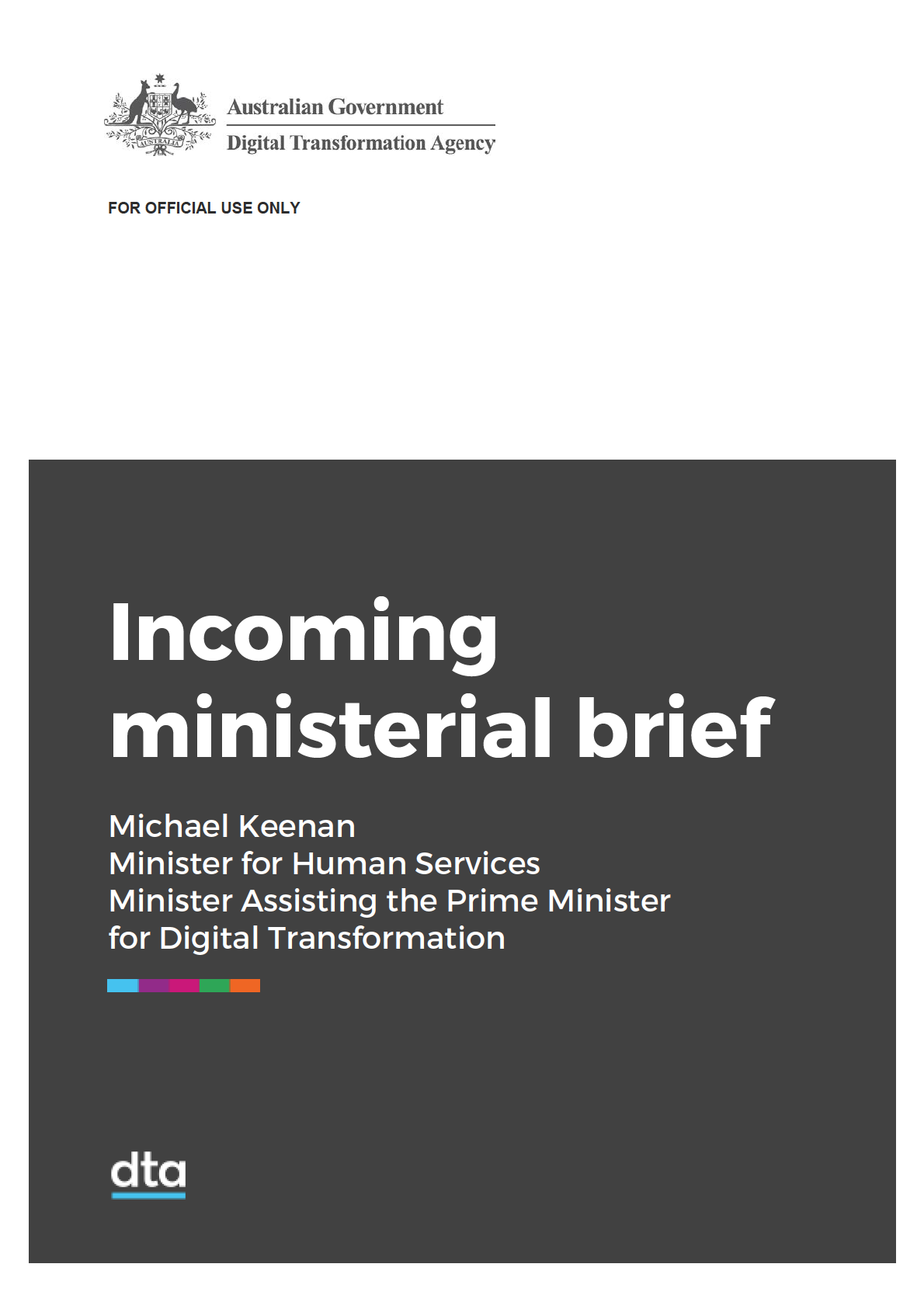
Contents
Introduction ......................................................................................................................... 1
DTA purpose and priorities ................................................................................................ 2
DTA mission ......................................................................................................................................... 2
Purpose ................................................................................................................................................ 2
Priorities ............................................................................................................................................... 3
S.34(3)
Digital Transformation Priorities ........................................................................................................... 8
Other Cabinet commitments ................................................................................................................ 9
Upcoming briefs ................................................................................................................................... 9
How the DTA operates .......................................................................................................10
People ................................................................................................................................................ 10
Finances ............................................................................................................................................. 11
Additional information .......................................................................................................12
Attachment A ......................................................................................................................13
Establishing Order for DTA ................................................................................................................ 13
Attachment B ......................................................................................................................15
Organisational structure ..................................................................................................................... 15
Attachment C ......................................................................................................................16
CEO biography .................................................................................................................................. 16
Attachment D ......................................................................................................................17
2017 achievements and 2018 priorities ............................................................................................. 17
Platforms ............................................................................................................................................ 18
Attachment E ......................................................................................................................23
Corporate Plan variation 2017–2021 ................................................................................................. 23
iii
Attachment F ......................................................................................................................24
2015–16 Annual Report ..................................................................................................................... 24
Attachment G ......................................................................................................................25
CEO opening statement to Senate Estimates in October 2017 ........................................................ 25
CEO opening statement to Senate Estimates November 2017 ....................................................... 29
Attachment H ......................................................................................................................32
Digital Service Standard .................................................................................................................... 32
S.34(3)
iv
Introduction
Demand for digital government services has been rapidly growing for many years.
People are more reliant on digital channels than ever before, and expect simple, clear
and fast engagement with government, just as they have with business. The Digital
Transformation Agency (DTA) was established by the Australian Government in
response to this need.
The DTA’s mission is to accelerate and drive the digital transformation agenda for
government. A decentralised public service, with multiple and complex agendas,
requires the DTA to work across all departments and agencies to achieve alignment
on key digital transformation initiatives, priorities and to provide ongoing assistance,
monitoring and reporting for government to ensure success.
It is widely recognised there is significant room to improve how the government
delivers digital services to individuals and businesses. Despite annual investment of
between $6 and $7 billion in information and communications technology (ICT)
related projects, research indicates that around 50 per cent of Australians will
experience a problem accessing and using government services and that the federal
government lags other private industries in the migration of services to online
channels.
(Boston Consulting Group,
2014)
It is important to note that these figures exclude the annual business-as-usual running
costs for ICT infrastructure, systems and service delivery and therefore significantly
more costs are incurred in supporting the whole-of-government ICT environment.
FOR OFFICIAL USE ONLY
Digital Transformation Agency— Incoming ministerial brief
1
DTA purpose and priorities
DTA mission
The DTA is committed to improving the user experience of government services by
working with other agencies and putting users at the centre of government service
delivery.
Purpose
To provide the necessary focus, achievement of outcomes and measurement of
impact, the CEO has agreed to three core digital transformation objectives with the
Prime Minister and the former Assistant Minister for Cities and Digital Transformation.
These are to:
•
encourage investment in digital services
•
help to transform the user experience for people and businesses
•
improve the return on ICT and digital investment.
FOR OFFICIAL USE ONLY
2
Digital Transformation Agency — Incoming ministerial brief
Priorities
To achieve the above outcomes, the DTA centres its activities and engagement with
agencies across five key priority areas.
1.
Develop a digital transformation roadmap
The roadmap will allow the government to identify and fund the digital transformation
initiatives that will have the greatest impact on the delivery of the core objectives.
Most digital services are designed to address the needs of a single portfolio or
agency, but for many people, they will have to contact many different agencies to get
one thing done. By tracking user journeys across government, we can better assess
and advise where to invest.
Key deliverables:
•
Digital transformation roadmap
•
Digital transformation priorities
•
Digital content and rationalisation strategy
2.
Deliver and improve digital platforms
A digital platform is a capability that multiple agencies can use to deliver services.
By reusing and sharing digital platforms, agencies can reduce duplication of effort,
expenditure and assets. This approach will save money, improve the experience of
government services and increase familiarity with government digital systems. An
example is a payments platform that could be used by all agencies to receive and
make payments. The advantages to this approach are a consistent user experience
and cost efficiencies for government.
Key deliverables:
•
Digital Identity
•
myGov
FOR OFFICIAL USE ONLY
Digital Transformation Agency— Incoming ministerial brief
3
•
Pilot platforms (Notifications, Tell Us Once, Payments In and Data Exchange)
•
Secure cloud strategy
•
Performance Dashboard
•
data.gov.au and NationalMap
3.
Oversee and advise on ICT and digital investment
The DTA provides central oversight and advice on all significant government ICT
and digital investments. This allows the DTA to better align investments to the
government’s transformation agenda and recommend technology and delivery
options. The DTA will also consider potential risks, assess cost effectiveness, find
opportunities to share platforms, coordinate procurement, and ultimately, ensure
projects are delivering their intended benefits for users and for the government.
Key deliverables:
•
Support effective ICT investment decision making by government
•
Oversee and advise on the delivery of major ICT initiatives
•
Provide cyber security advice
•
Review critical infrastructure risks
•
Review internet gateway reduction program
FOR OFFICIAL USE ONLY
4
Digital Transformation Agency — Incoming ministerial brief
4.
Transform ICT procurement
The DTA develops and provides guidance to agencies on applying ICT procurement
policy. The ICT procurement team is working to support best practice procurement,
inclusive markets and good working relationships between buyers and sellers. This
will mean that agencies can embrace modern and agile ways of doing business.
Key deliverables:
•
Transform government ICT procurement
•
Undertake coordinated procurement
•
Continue to improve the Digital Marketplace
5.
Build Australian Public Service ICT and digital capability
The DTA is partnering with agencies across government to raise the level of digital
skills in the Australian Public Service. This will help government to design and deliver
the best digital experiences for users and champion the adoption of digital service
delivery. Building internal digital capability makes the public service less exposed to
increasing market rates for contractors, reduces design and delivery risk, and will
encourage innovative thinking.
Key deliverables:
•
Review and build on the Digital Service Standard
•
Build a whole-of-government digital capability program
•
Develop Co-Lab sites for agencies to share, learn and collaborate
•
Deliver the whole-of-government ICT entry-level graduate, cadet and
apprenticeship programs
•
Partner with agencies to co-deliver new digital services
FOR OFFICIAL USE ONLY
Digital Transformation Agency— Incoming ministerial brief
5
S.34(3)
FOR OFFICIAL USE ONLY
6
Digital Transformation Agency — Incoming ministerial brief
S.
3
4(
3)
FOR OFFICIAL USE ONLY
Digital Transformation Agency— Incoming ministerial brief
7
S.34(3)
FOR OFFICIAL USE ONLY
8
Digital Transformation Agency — Incoming ministerial brief
S.34(3)
FOR OFFICIAL USE ONLY
Digital Transformation Agency— Incoming ministerial brief
9
How the DTA operates
The DTA uses agile development to iterate quickly and deliver value to users.
In contrast to traditional development methodologies like waterfall, agile development
requires continuous delivery, improvement and feedback from users. The benefit is
that teams can quickly adapt and align services with user needs in rapidly changing
environments.
People
The DTA has four offices—two main offices in Canberra and one in Sydney, and a
small office in Melbourne. There is about a 90/10 split of staff across Canberra and
Sydney. The agency has 222 public service staff (204 ongoing and 18 non-ongoing),
14 secondees and about 50 contractors (as at 30 November 2017).
The DTA’s staff is a mix of ongoing, non-ongoing, secondees and contractors, which
reflects the agency’s need to engage specialist skills for high priority and fluctuating
policy and programs. The DTA currently sponsors two staff on Temporary Work
(Skilled) visas (457s) due to their specialist capabilities. Both these employees are in
the process of securing permanent residency with a view to citizenship.
The DTA is also in the process of negotiating its first Enterprise Agreement for
the agency.
FOR OFFICIAL USE ONLY
10
Digital Transformation Agency — Incoming ministerial brief
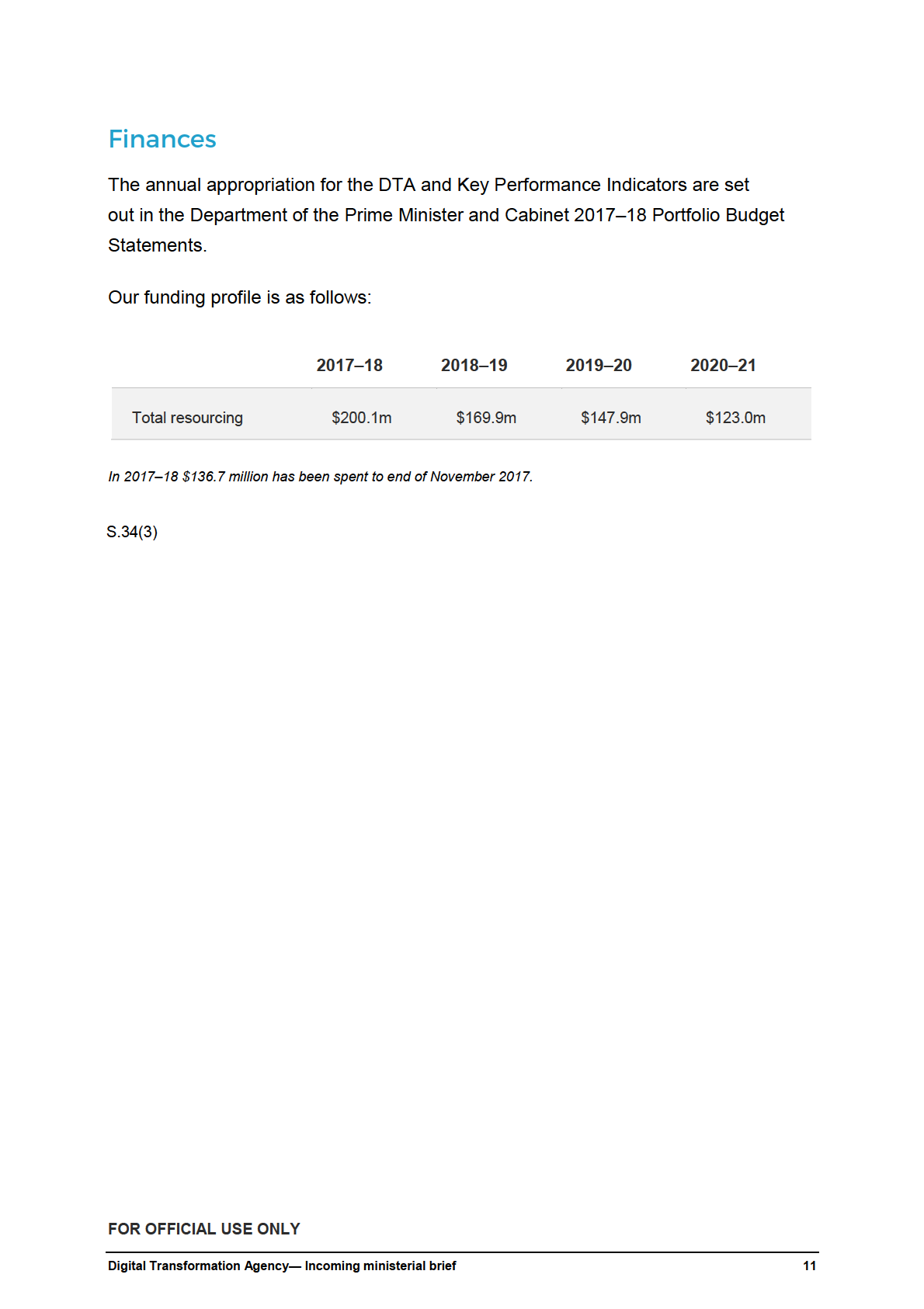
Additional information
Attachments:
•
Attachment A –
Establishing Order for DTA
•
Attachment B –
Organisational structure
•
Attachment C –
CEO biography
•
Attachment D –
2017 achievements and 2018 priorities
•
Attachment E –
Corporate Plan variation 2017–2021
•
Attachment F –
2015–16 Annual Report
•
Attachment G –
CEO opening statement to Senate Estimates in October 2017
and November 2017
•
Attachment H – Digital Service Standard
•
S.34(3)
FOR OFFICIAL USE ONLY
12
Digital Transformation Agency — Incoming ministerial brief
Attachment A
Establishing Order for DTA
https://www.legislation.gov.au/Details/C2016G01423
FOR OFFICIAL USE ONLY
Digital Transformation Agency— Incoming ministerial brief
13
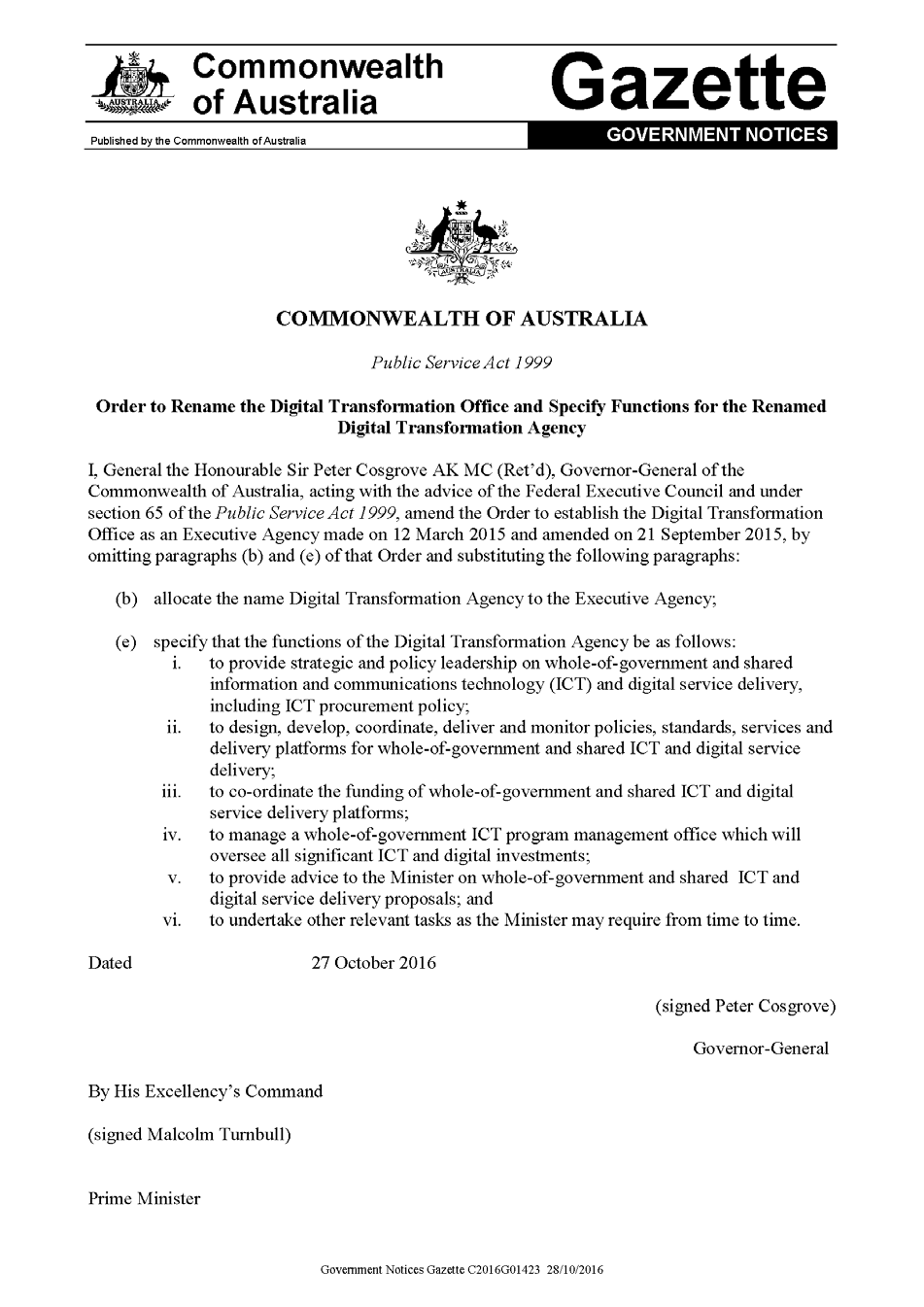 FOR OFFICIAL USE ONLY
14
Digital Transformation Agency — Incoming ministerial brief
FOR OFFICIAL USE ONLY
14
Digital Transformation Agency — Incoming ministerial brief
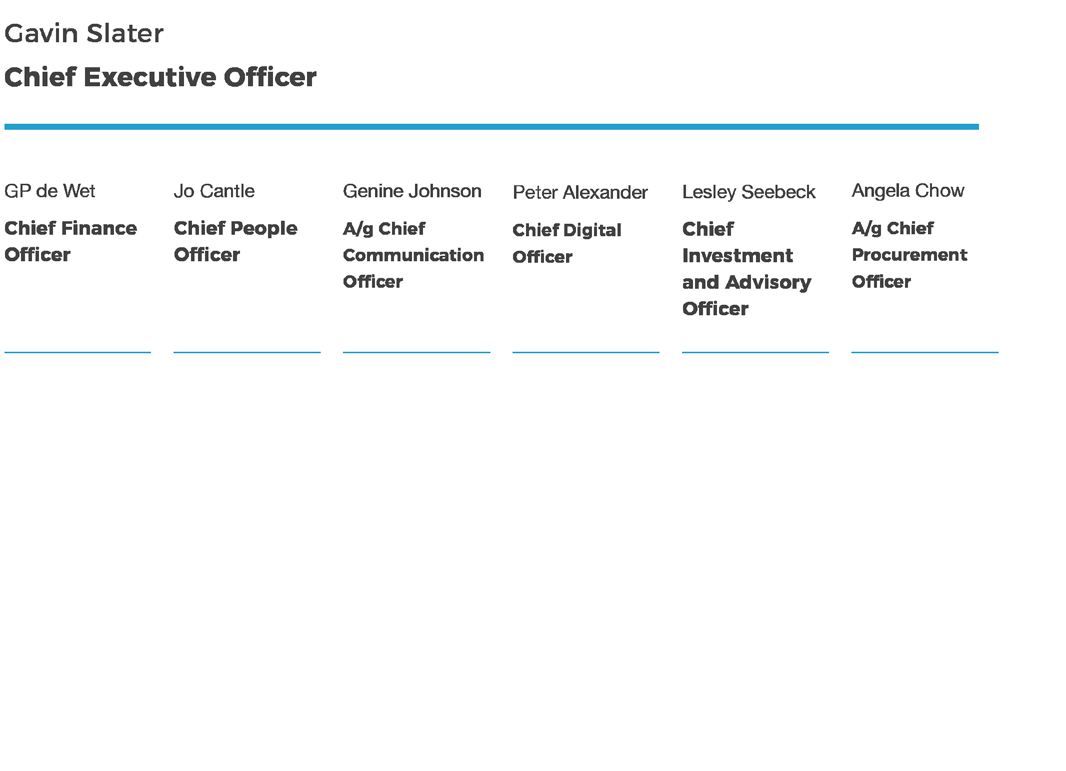
Attachment B
Organisational structure
FOR OFFICIAL USE ONLY
Digital Transformation Agency— Incoming ministerial brief
15
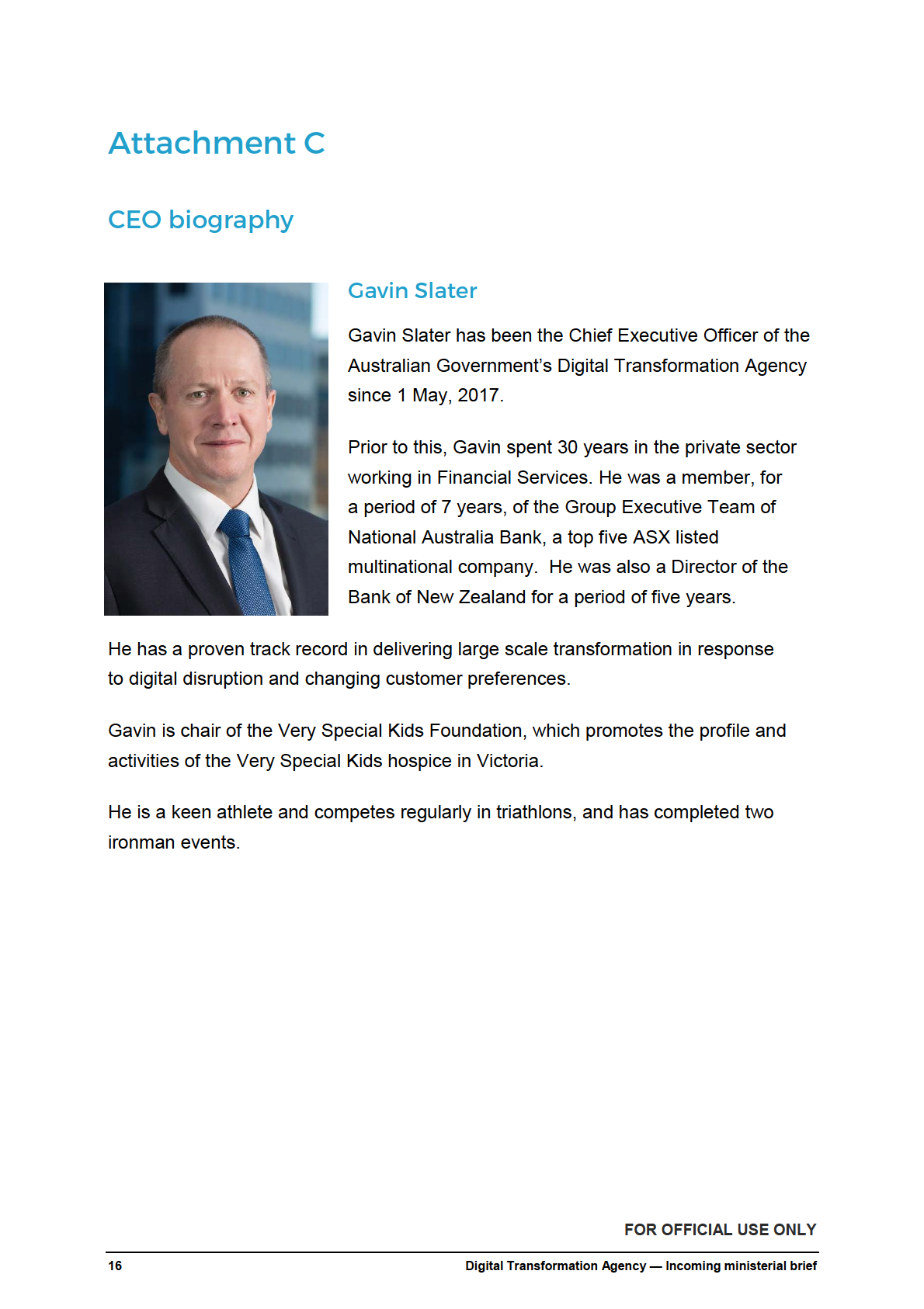
Attachment D
2017 achievements and 2018 priorities
Digital Transformation Roadmap
•
S.34(3)
•
Finalised a business services transformation roadmap.
•
Worked with more than 12 agencies to develop an innovative model to help to
identify Digital Transformation Priorities based on user needs and research on
gaps in service delivery with a focus on:
−
highest volume and impact end-to-end and joined-up user journeys
−
whole-of-government platforms to underpin better services
−
quality of individual large scale services
−
resilience of digital and ICT infrastructure.
•
Completed “Looking for Work” life event and “Newstart” service journeys.
Next steps for 2018:
•
Develop a live list of high value opportunities to improve the quality and maturity
of information and transaction services and create whole-of-government
platforms.
•
Develop a transformation services roadmap for individuals.
•
Finalise a model that will help to identify Digital Transformation Priorities.
•
S.34(3)
FOR OFFICIAL USE ONLY
Digital Transformation Agency— Incoming ministerial brief
17
Platforms
Built a working beta of Govpass, a platform that will allow people to prove their
identity online and access government services more easily.
Consulted with stakeholders on the digital identity draft rules and standards — the
Trusted Digital Identity Framework — that will determine a nationally-consistent
approach to digital identity.
Expanded the Performance Dashboard — where all agencies can report on how their
services are performing and launched the National Cities Performance Framework
Dashboard with the Department of the Prime Minister and Cabinet.
Delivered improvements to the myGov website (with the Department of Human
Services) to be more mobile responsive, have simplified content and a new look and
feel so it’s easier for users to navigate.
Next steps for 2018:
•
Develop a Beta for the Trusted Digital Identity Framework.
•
Complete Discovery and Alpha for Notifications platform.
•
Complete Discovery and Alpha for Tell us Once platform.
•
Develop myGov Business outcomes metrics.
•
Develop myGov Deliver Inbox functionality to JobSearch.
•
Onboard the Victorian State Revenue Office and National Cancer Screening
Register to myGov.
Oversee and advise on ICT and digital investment
•
Set up a whole-of-government Digital Investment Management Office and gained
early insights into the government’s investment into major ICT projects.
•
Initiated the Digital Investment Review — a bi-monthly collection of data on all
ICT projects of more than $10 million. The review is now in its fourth collection
period.
FOR OFFICIAL USE ONLY
18
Digital Transformation Agency — Incoming ministerial brief
•
S.34(3)
•
Provided ongoing oversight and assurance support to 17 projects representing
43% of the investment portfolio.
•
S.34(3)
•
Set up the Cyber Security Advisory Unit.
•
S.34(3)
Next steps for 2018:
•
Continue bi-monthly collection of project performance data and refine this
capability.
•
Develop a whole-of-DTA data strategy to best capture data collections within the
DTA and across government.
•
Extend the DTA’s oversight and assurance practice to deliver increasing value to
agencies and government.
S.34(3)
•
Develop for government agencies a digital transformation strategy to improve
collaboration and sharing of data, extending into platforms, technologies and
networks.
•
Establish the set of standards—architectural, data, user, security—against which
all proposals would be assessed.
FOR OFFICIAL USE ONLY
Digital Transformation Agency— Incoming ministerial brief
19
•
Finalise review into critical ICT infrastructure, secure internet gateways and other
projects (including classified work in the national security community) as directed.
•
Develop a whole-of-government data centre strategy.
ICT procurement
•
Reviewed government ICT procurement practices and announced a series of
reforms including a policy to cap the term and value of contracts to benefit small
and medium enterprises (SMEs).
•
Negotiated a whole-of-government contract with SAP Australia.
•
Awarded more than 72% of the $55 million contracted value through the Digital
Marketplace to SMEs. In addition, around 47% of $1.47 billion spent through
whole-of-government ICT coordinated procurements were awarded to SMEs.
•
S.47, S.47G, S.11A(5)
•
Built a smart cities collaboration platform on the Digital Marketplace to connect
local government councils across Australia so they can work together on smart
cities initiatives.
•
Hosted a series of roundtables with industry CEOs and government buyers.
•
Released new procurement pathway “Dynamic Pricing” as an minimum viable
product in private Beta.
•
Released discussion paper for a new Hardware Marketplace.
•
Completed a one-year review of the Digital Marketplace.
•
Developed a draft Memorandum of Understanding with the AIIA to strengthen the
DTA’s work with industry.
FOR OFFICIAL USE ONLY
20
Digital Transformation Agency — Incoming ministerial brief
Next steps for 2018:
•
Establish a whole-of-government IBM agreement.
•
Establish a whole-of-government Oracle agreement.
•
Launch a whole-of-government Software Licensing and Services Panel (Microsoft
Licensing Solutions Provider category).
•
Launch Hardware Marketplace to expand the scope of the Marketplace for
hardware sellers.
•
Develop an ICT spend dashboard.
•
Release ICT Procurement Framework and an initial set of policy principles for
consultation.
•
Set minimum viable products on catalogue based e-procurements and “Ask the
market”.
•
Release minimum viable product of standard contracting terms for contracts
below $200,000.
•
Get agreed agency spending targets and metrics for annual reporting.
Digital capability
•
Rolled out Digital Service Standard training to 2000 public servants.
•
Reviewed the Digital Service Standard.
•
Worked with the Australian Public Service Commission on a program to attract,
build and retain digital talent, develop digital leadership skills, and create digital
training standards.
•
Coordinated the government’s ICT entry-level graduates, apprentices and cadets
programs for 2018, which attracted nearly 1400 applications and will see about
170 new ICT staff being placed in departments and agencies next year.
FOR OFFICIAL USE ONLY
Digital Transformation Agency— Incoming ministerial brief
21
•
Finalised the entry-level programs in 2017 for 116 apprentices, cadets and
graduates who are now entering the workforce as new ICT professionals in
18 government agencies.
•
Matched 19 women working in IT with Chief Information Officers as part of
the Women in IT Executive Mentoring Program.
•
Recognised 73 women as high performing executive level staff through the
Women in IT Coaching Program who will now participate in a 12-month
facilitated program.
•
Worked with more than 30 agencies on a strategy to improve content on
government websites so users have a simpler and clearer experience.
Next steps for 2018:
•
Deliver Alpha of new mentoring program for ICT employees across the
public service.
•
Introduce a new stream in cyber security for the ICT level programs.
•
Launch 2018 Data Fellowship Program in collaboration with Data61.
•
Release 12 Learning Design Standards on a new dedicated training section
of the Digital Marketplace.
•
Deliver Alpha of APS digital capability diagnostic tool.
•
Co-design with the Australian Public Service Commission career pathways and
talent management strategy for APS digital practitioners.
•
Co-develop with agencies an additional 14 content strategy modules, taking the
total to 21.
•
Create a prototype of the 7th edition of the Style Manual in collaboration with
agencies.
•
Develop new capability uplift program to improve uptake of digital service
standard across the public service.
FOR OFFICIAL USE ONLY
22
Digital Transformation Agency — Incoming ministerial brief
Attachment E
Corporate Plan variation 2017–2021
https://www.dta.gov.au/who-we-are/corporate/plan-2017-20/
FOR OFFICIAL USE ONLY
Digital Transformation Agency— Incoming ministerial brief
23
Attachment F
2015–16 Annual Report
https://www.dta.gov.au/who-we-are/corporate/annual-report/
FOR OFFICIAL USE ONLY
24
Digital Transformation Agency — Incoming ministerial brief
Attachment G
CEO opening statement to Senate Estimates in October
2017
Chair, I would like to make a brief opening statement.
I have been in this role for six months and have spent considerable time meeting with
hundreds of people across government and in the private sector — to listen, learn and
discover, and to build relationships.
I’ve also spent time making changes to the agency to better align our work to the
government’s key objectives, which are to:
•
digitise more services
•
improve the user experience for individuals and businesses, and
•
improve the return on ICT and digital investment.
With these objectives in mind, we focus our work on those areas that are the most
important and have the greatest impact.
We provide advice to government to ensure it’s making the right ICT investment
decisions — that it’s investing in those areas that will deliver benefits and outcomes to
the public and better services at lower cost.
Once those investment decisions are made, we have a role to work with agencies to
help them set up their major ICT projects for success.
This includes helping them to apply agile project methodologies, to focus on user
needs, ensure the right technologies and platforms are being used, that they’re
leveraging existing platforms and avoiding duplication, moving to cloud, and getting
the vendors with the right capability in.
FOR OFFICIAL USE ONLY
Digital Transformation Agency— Incoming ministerial brief
25
Our role to deliver quality digital products that can be used across government
remains an important aspect of this work.
And finally, we undertake ongoing monitoring of the ICT portfolio. We provide advice
to government — to inform its decision making — about how major ICT projects are
performing, managing risks and delivering on intended benefits.
I would now like to touch on some of the key whole-of-government priorities we are
working on.
Last week we released a private beta of the Govpass technology platform, which is a
critical initiative that will give people the option to create a digital identity so they can
more easily access government online services.
We are currently trialling the technology and we anticipate testing it more broadly
next year.
We’ve also released the latest version of the rules and standards that will form a
framework for a nationally-consistent approach to digital identity. We are currently
consulting with government, industry and privacy groups on this and we’ll shortly be
releasing it for broader public comment.
The second focus of work I’d like to share with you is our responsibility for ICT
procurement, including setting up and managing ICT coordinated procurement
arrangements.
This is designed to simplify, consolidate and coordinate ICT procurement across
government and deliver significant savings.
For example, a new strategic arrangement with SAP was announced last week.
Under the deal, we negotiated significantly discounted pricing for commonly used
products and services. All agencies will benefit from the same discounts and reduced
administrative burden.
We have also completed a review of how government undertakes ICT procurement.
Based on the review findings, we have established a cap to limit ICT contracts to a
maximum of $100 million and/or three years’ duration. The intent of this cap is to
FOR OFFICIAL USE ONLY
26
Digital Transformation Agency — Incoming ministerial brief
benefit small and medium enterprises who will now have the opportunity to bid for
smaller individual components of larger projects.
We are continuing to work with industry and government on more reforms to improve
coordination and reduce duplication of ICT products and services across government,
as well as identify new ways to make the procurement process quicker, easier and
more cost effective.
Our new investment oversight and advisory role of major government ICT projects is
another key piece of work we are doing.
It is providing some important early insights to government about where its major
ICT investment is being directed and how major projects are tracking against their
intended delivery schedule and benefits.
Just six months into this work, we have established a good baseline of information
that we can continue to build on as we collect more detailed information about major
projects.
We’ve identified 72 projects that fall within the scope of being above $10M and we are
engaging actively on 17 of these.
Separate to these insights, we have also provided advice to government on 16 new
ICT project proposals to help with their investment decision.
This oversight and provision of advice is the first of its kind for the government
and the emerging insights highlight the importance of the DTA playing this central
advisory role.
As we continue to collect and analyse information, we’ll also gain a stronger
understanding of the priority areas for skills uplift in the public service so we can
improve how projects are managed and increase the likelihood of them succeeding.
Which brings me to the fourth key area of focus I’d like to talk about —
building digital capability.
FOR OFFICIAL USE ONLY
Digital Transformation Agency— Incoming ministerial brief
27
It’s crucial that public servants are well placed to deliver and support the
government’s digital transformation ambitions.
One example of our work in this area is with the Australian Public Service
Commission to design training programs to upskill the public service. These will
help to attract and retain digital talent across government, provide digital training
to agencies, and deliver a digital transformation leadership program to senior public
servants.
We’re continuing to roll out Digital Service Standard training across the public service,
which sets out best practice guidelines for building government services that are
simple, clear and fast.
We’re bringing in fresh talent to the public service through the whole-of-government
ICT entry level programs that we now manage. We expect to place about 170 ICT
graduates, cadets and apprentices in departments and agencies in the coming year.
We’ve also set aside space in our Sydney and Canberra offices where we can
collaborate with the private sector and external experts, and offer agencies training
and hands-on learning opportunities to transform government services using new
approaches and methodologies.
FOR OFFICIAL USE ONLY
28
Digital Transformation Agency — Incoming ministerial brief
CEO opening statement to Senate Estimates
November 2017
Good evening senators and thank you for the opportunity to appear before you today.
I would like to add a short opening statement to the one that I tabled at the
last hearing.
I want to take this opportunity to briefly share my perspectives on digital
transformation after six months in the CEO role.
As the committee may well be aware, I have worked in the financial services sector
for 30 years, and more notably, in the latter years, led large scale and complex whole-
of-business transformation programs.
These programs all had similar ambitions to that of the federal government.
Firstly, to support the desire of individuals and businesses to be able to do more
digitally — to be empowered to access the information and services they need at
a time, place and method of their choosing.
Secondly, to have an improved service experience that is easy, accessible,
safe and secure.
And thirdly, to improve the overall economics of providing that service. That is, to
significantly improve the overall productivity of the operating environment or business.
Experience shows that to achieve these ambitions, we require a different mindset,
approach and capabilities to those that were traditionally used in the past.
The pace of change is being driven by the availability of new and emerging
technologies, expectations of citizens and the capability of people.
It has often been said, and I believe it to be true, that culture eats strategy
for breakfast.
FOR OFFICIAL USE ONLY
Digital Transformation Agency— Incoming ministerial brief
29
I know, based on my experience, that to successfully deliver meaningful
transformation, it must start at the top of any organisation and requires leaders to be
completely orientated and vested in the business outcomes they are seeking to
achieve.
It requires a clear articulation of the issues to be solved and the opportunities to be
embraced.
There needs to be a culture that encourages innovation and a drive to smaller and
more discrete programs of work.
Time must be spent doing the discovery work and mapping out the key customer
journeys.
We need to work in an agile way, build prototypes to test thinking and demonstrate
potential solutions, and partner effectively with the private sector to bring the very best
capability and solutions to bear in short timeframes.
We must be prepared to fail, but fail fast and make sure that the costs of failure are
far outweighed by the benefits of the learnings gained. This does require a culture
that recognises the value of learning.
Large, multi-year, billion dollar programs with benefits realisation delivered far into the
future is not the way anymore. Rather, we need smaller agile projects that regularly
deliver key outcomes and benefits as building blocks to the overall transformation.
This approach provides the flexibility to more easily adjust to change in
circumstances, priorities and to take full advantage of new capabilities as they
emerge.
Importantly, this does not negate the need for long term vision and continued
investment in core legacy systems, processes and knowledge management. It is
important that an appropriate level of investment continues to be directed towards
maintaining a level of currency in our systems environment to reduce the risks of
outages and improve our delivery of services.
FOR OFFICIAL USE ONLY
30
Digital Transformation Agency — Incoming ministerial brief
The DTA is playing a critical role and will continue to do so by working constructively
across the public service, with government and industry to help bring about this
change.
We do this by:
•
advising government where to best invest
•
ensuring new initiatives are set up for success by drawing on the DTA’s
expertise, as well as private sector capability, and
•
providing ongoing appraisal and advice to government on their ICT project
portfolio.
Thank you.
FOR OFFICIAL USE ONLY
Digital Transformation Agency— Incoming ministerial brief
31
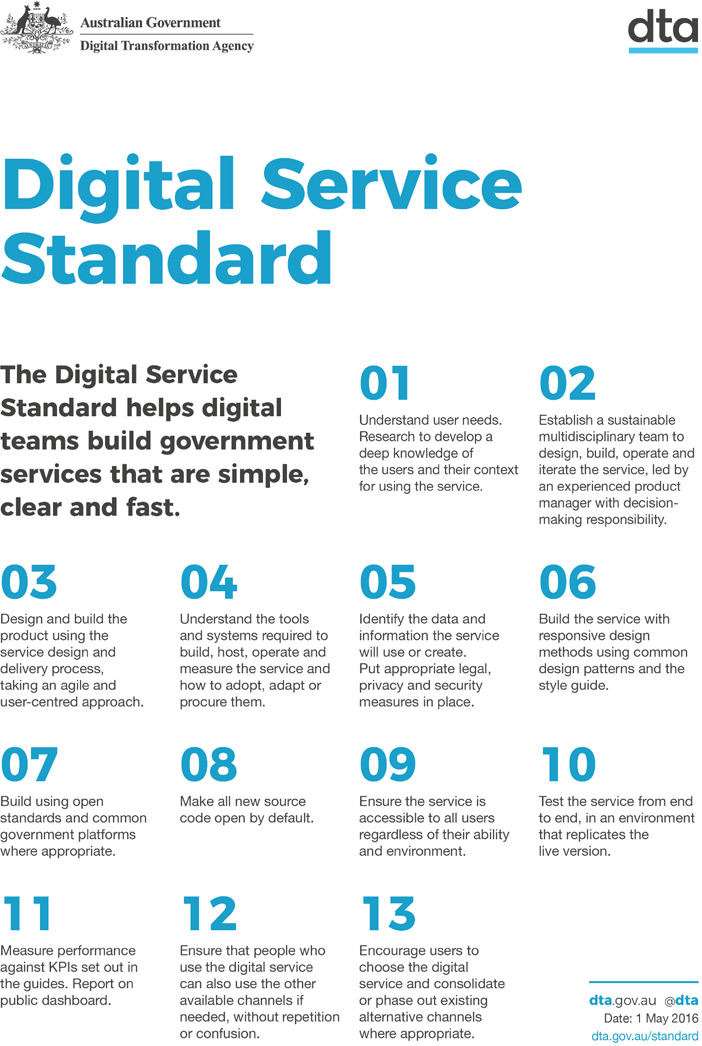
Attachment H
Digital Service Standard
https://www.dta.gov.au/standard/
FOR OFFICIAL USE ONLY
32
Digital Transformation Agency — Incoming ministerial brief
S.34(3)
FOR OFFICIAL USE ONLY
Digital Transformation Agency— Incoming ministerial brief
33







